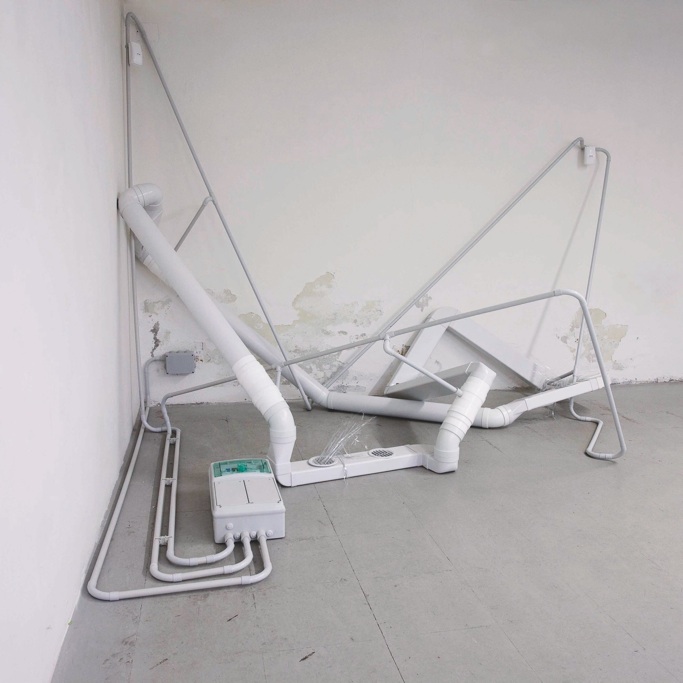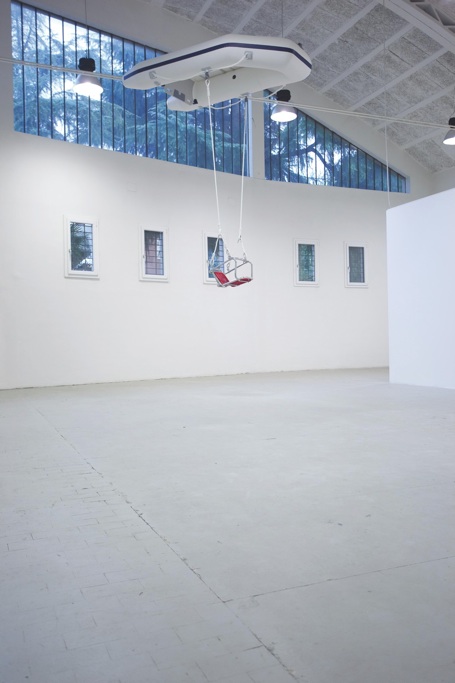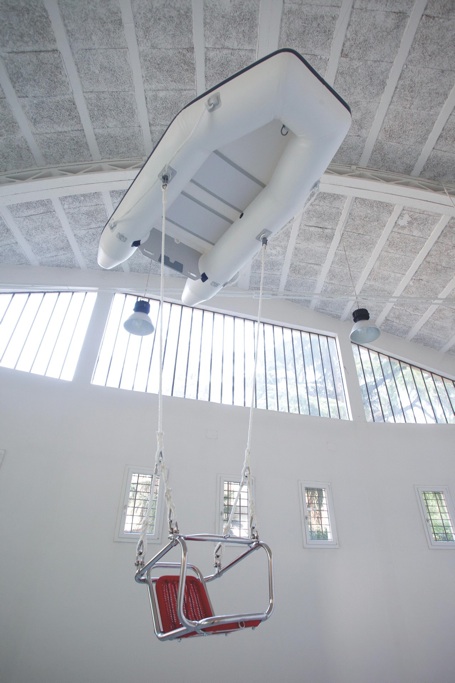ALEX
BELLAN

![[1.1] Home](exibition_import_export_files/shapeimage_2.png)
![[1.2] Work](exibition_import_export_files/shapeimage_3.png)

“ IMPORT EXPORT”
2009
Gallery Perugiartecontemporanea , Padova
text : Guido Bartorelli
I lavori di Alex Bellan sembrano ready made. In realtà Bellan non li trova affatto “già fatti”. Anzi, il suo contributo tecnico è decisivo. E richiede un’abilità non comune. Sin dagli esordi egli ha fatto una scelta precisa, l’oggetto. Ma l’oggetto, nell’arte di Bellan, non rimane fisso e statico, come una fortezza inespugnabile. Esso è aggredito, offeso, deformato. Ciò non avviene – per così dire – in virtù di un attacco dall’esterno, quali quelli, storicamente esemplari, inferti dagli artisti del Nouveau Réalisme. Bellan agisce dall’interno, al livello genetico: è un costruttore che esegue un progetto guasto, inficiato da uno o più errori. L’oggetto che ne risulta appare intatto e pulito, ma proprio per questo l’aberrazione che vi è inscritta, una volta che la si colga, risulta ancor più sconcertante.
Bellan riesce a plasmare l’oggetto a suo piacimento, rendendolo docile come fosse il più morbido dei materiali da modellazione. Non si tratta quindi di ready made, e nemmeno della variante del “ready made aiutato”, dove l’oggetto subisce sì una manipolazione ma di natura leggera e che, solitamente, non richiede un particolare talento manuale. Preferisco definire gli oggetti di Bellan “ready made truccati”, perché appunto hanno l’aspetto asettico del ready made ma col trucco che non lo sono. Ma anche perché per realizzarli è necessaria una mano abile da meccanico, tipo quella dei ragazzini che “truccano” il motore dello scooter o dell’ape-car, e poi magari ne modificano la carrozzeria o la ridipingono con immaginifici inserti cromati.
Bellan dimostra un atteggiamento di supremazia nei confronti dell’oggetto. Viene meno la reverenza al cospetto delle cose. Un tempo le cose ci hanno sovrastato e noi ne siamo diventati i cultori devoti, premurosi affinché restassero linde e lucide, come appena comprate. La pratica del lustrare il proprio oggetto di culto – l’hi-fi, lo scooter, l’automobile… – appartiene al passato, o a un’età già avanzata. Progressiva è invece la tendenza a personalizzare le cose fino al limite di adulterarle, violentarle, brutalizzarle. È la rivincita del soggetto che afferma se stesso e la sua pittoresca unicità. Cosicché ciò che si acquista finisce per essere la materia prima sulla quale stampare la propria impronta. La street art, che qui evoco non come tendenza artistica – con la quale Bellan ha ben poco da spartire – ma come spontanea espressione giovanile, si fonda su questo atteggiamento e lo dispiega a tutti i livelli, dalle magliette alla tavola dello skate, a quelle maxi-cose che sono le città. Di tutto ciò si sono accorte da tempo le stesse industrie produttrici, che infatti tendono a cavalcare la tendenza mirando a mettere sul mercato oggetti che fungano da supporto alla soggettivizzazione. Ne è esempio il fatto che è sempre più difficile incrociare due modelli identici di alcuni tipi di automobili, pensati appositamente per le nuove generazioni. Automobili che, non per niente, hanno riscosso un successo enorme. Tra i primi lavori di Bellan, Monociclo mostra in maniera già compiuta questo suo modo di procedere. L’oggetto indicato dal titolo ostenta se stesso, nella sua integrità. Basta poco, però, per accorgersi che si tratta di un assurdo. L’inerzia con cui ci appare non riesce a nascondere l’energia del paradosso. Bellan ne ha infatti modificato l’altezza rendendolo uno strumento inservibile, o meglio una micidiale macchina per cadute, per far rovinare a terra chiunque provasse a montarla. In questo modo l’oggetto perde la sua ottusità e diventa emozionale, raggiante di pensiero soggettivo. L’attrezzo truccato è un dolorosamente sarcastico “ritratto dell’artista da giovane”, ossia di colui che è costretto a mille equilibrismi pur di emergere in una “missione impossibile”.
In un’opera d’esordio come Monociclo, Bellan prendeva le mosse, come è giusto che fosse, a partire da se stesso, dalla sua personale esperienza. Ma già allora si scorgeva la possibilità di allargare il discorso schiudendolo a orizzonti collettivi. Infatti il lavoro può anche essere letto, in termini più generali, come il ritratto del giovane tout court, che – come è noto – è una delle categorie sociali più deboli e bistrattate.
Questa tensione sociale è ciò che si impone negli ultimi lavori che compongono il progetto Import/Export, e nel modo più drammatico. White boat è un gommone che galleggia in aria. O meglio che prova a non colare a picco nel tragico quotidiano. Un quotidiano che purtroppo lo sta rendendo di un’attualità sempre più bruciante. Evidentemente White boat tratta del sogno di un approdo. Ma il gommone si trascina sotto di sé, forse a sua insaputa, un seggiolino da giostra, più precisamente della giostra comunemente detta “calci in culo”. Calci in culo, detto davvero molto comune, e non in riferimento alla giostra.
In 50 hz Bellan assembla dei tubi creando un’installazione che ha l’aspetto di una scultura astratta. Di grande intensità e molto scultoreo nel senso più nobile è il delicato gioco di statica che mantiene ogni tubo in equilibrio. La forma è il risultato delle necessità della statica, non di altro. Ma il talento di Bellan nel manipolare l’oggetto non deve farci dimenticare l’identità dell’oggetto e le sue connotazioni. I tubi sono quelli dove fluisce l’aria nei comuni impianti di condizionamento. Bellan li ha sfilati dal muro per rivelare l’organo polmonare che attraversa le nostre abitazioni. Non essendo progettato per auto-sostenersi, esso tende a raggomitolarsi su di sé. Al tempo stesso perde ogni funzionalità finendo per respirare il proprio respiro in un riciclo asfittico e vizioso, malgrado il fruscio dell’aria dia un’ingannevole impressione di salubrità. Al tema dell’ossessione di una domesticità fresca e pulita, Bellan incrocia quello, correlato, della sicurezza. L’installazione comprende anche un sensore di presenza, di quelli che fanno scattare gli allarmi. Cosa succede quando l’“interno” si richiude su se stesso respingendo l’“esterno”? Quanto può perdurare un sistema senza entrate e senza uscite?
![[1.6] Contact](exibition_import_export_files/shapeimage_4.png)
![[1.5] News](exibition_import_export_files/shapeimage_5.png)
![[1.4] CV](exibition_import_export_files/shapeimage_6.png)
![[1.7] Link](exibition_import_export_files/shapeimage_7.png)
![[1.3] project](exibition_import_export_files/shapeimage_8.png)


Alex Bellan’s works look like ready mades, however Bellan does not find them ‘already made’ at all. On the contrary, his technical intervention is key and shows uncommon skill. From the start he has concentrated on the object. Objects, however, in Bellan’s work are not fixed and static, like an impenetrable fortress. Rather, they are attacked, offended and deformed. However this is not from an external aggression such as the historical example of those of the Nouveau Réalisme artists. Bellan operates from within on a genetic level; he is a constructor carrying out a faulty project, undermined by one or more errors.
The resulting object appears intact and clean, and this only heightens the shocking effect of its intrinsically deviant nature once it is perceived.
Bellan manages to mould the object to his liking, making it as docile as the softest of clays. His work is not a ready made, nor is it a form of “assisted ready made” where the object is tampered with, but only slightly, not requiring any particular manual skill. I prefer to call Bellan’s works “turbo charged ready mades” since they share the aseptic look of ready mades, but in fact they are not ready mades at all. Not least because the skilful hand of the mechanic is needed in order to create them, the same skill as that of youngsters tuning-up scooters and vehicles, perhaps modifying the bodywork or repainting them which fantastic chromed badges.
Bellan displays an attitude of supremacy towards the object. He shows little respect towards things. Once things used to command us, making us their devoted followers, carefully preserving them clean and shiny as if they were still brand new. The practice of keeping the objects we worship polished- hi-fi’s, scooters, cars- is more often associated with the past, or older people. On the other hand there is a developing trend for making things unique and personal, to the point of adulterating, abusing and roughing them up. It is the revenge of the subject which affirms itself and its picturesque uniqueness. As such that which we buy becomes the raw material upon which to make your own mark.
If we consider Street art- which Bellan has very little direct connection with- not so much as an artistic movement but as a spontaneous youthful expression, we can see that it is based on this attitude and spreads out on all levels, from t-shirts to skateboards to those maxi-things which are the city. Manufacturing industries have been aware of all this for some time, these are industries which tend to take advantage of the trends, seeking to place products on the market which serve as a base for subjectivisation. An example of this is that it is ever more unlikely to come across two identical models of car, designed specifically for the new generations. These are cars which, not by chance, have had enormous success. Amongst Bellan’s early work, Monociclo (unicycle) already shows his fully formed way of working. The object named in the title shows itself off, in its integrity. However it doesn't take much to realise that it is an absurdity. The inertia of its appearance cannot hide the energy of the paradox. Bellan has modified the height to make the device un-usable, or rather a devilish machine for falling off, for throwing to the floor anyone who tries to ride it. In this way the object looses its obtuse nature and becomes emotional, radiant with subjective thought. The modified device is a painfully sarcastic “portrait of the artist as a young man”, or rather of one who is forced to perform thousands of balancing acts simply to emerge from a “mission impossible”.In an early work, such as Monociclo, Bellan quite rightly started from himself and his personal experience. But even then there was a hint of the possibility to widen the discourse, opening it up to a collective vista. Indeed the work could also be read in more general terms as a portrait of youth in general, a group, as is well known, which is one of the weakest and most mistreated social categories. This social tension is the focus of the new works which make up the project Import/Export, and it is shown in a much more powerful way. White boat is an inflatable dinghy which floats in the air. Or rather it tries not to crash down into a tragic everyday world. An everyday world which is unfortunately becoming of evermore burning relevance. Evidently White boat is about the dream of landing, but the dinghy, perhaps unknowingly, is dragging the seat from a playground ride beneath it, specifically from a playground ride commonly known as “kick in the ass”. A kick in the ass, a very common expression, and not in reference to a playground ride.
In 50 hz Bellan has assembled a series of tubes to create an installation which looks like an abstract sculpture. It is very intense and highly sculptural in the most noble sense, a delicate game of balance holds the tubes in equilibrium. The form is the result of the necessities of balance, nothing else. But Bellan’s talent in manipulating the object should not distract us from the object itself and its connotations. The tubes are those used to direct air in normal air conditioning units. Bellan has pulled them out of the wall to reveal the pulmonary organ which passes through out houses. Not being designed to be self supporting, it tends to roll up into itself. At the same time it looses all functionality, ending up breathing its own breath in a vicious and asphyxial re-cycling, despite the flow of air giving the deceiving impression of healthiness. Bellan combines the obsession with a fresh and clean domestic environment with that for security. The installation also contains a motion detector, such as those found in alarm systems. What happens when the “internal” closes in on itself, driving out the “external”? How long can a system last without entrances or exits?




“white boat” , 2009
canotto, corde, seggiolino della giostra “calci in culo”



“50Hz” 2009
circuiti, sensori,ventole,tubi e raccordi di plastica, carta plastificata